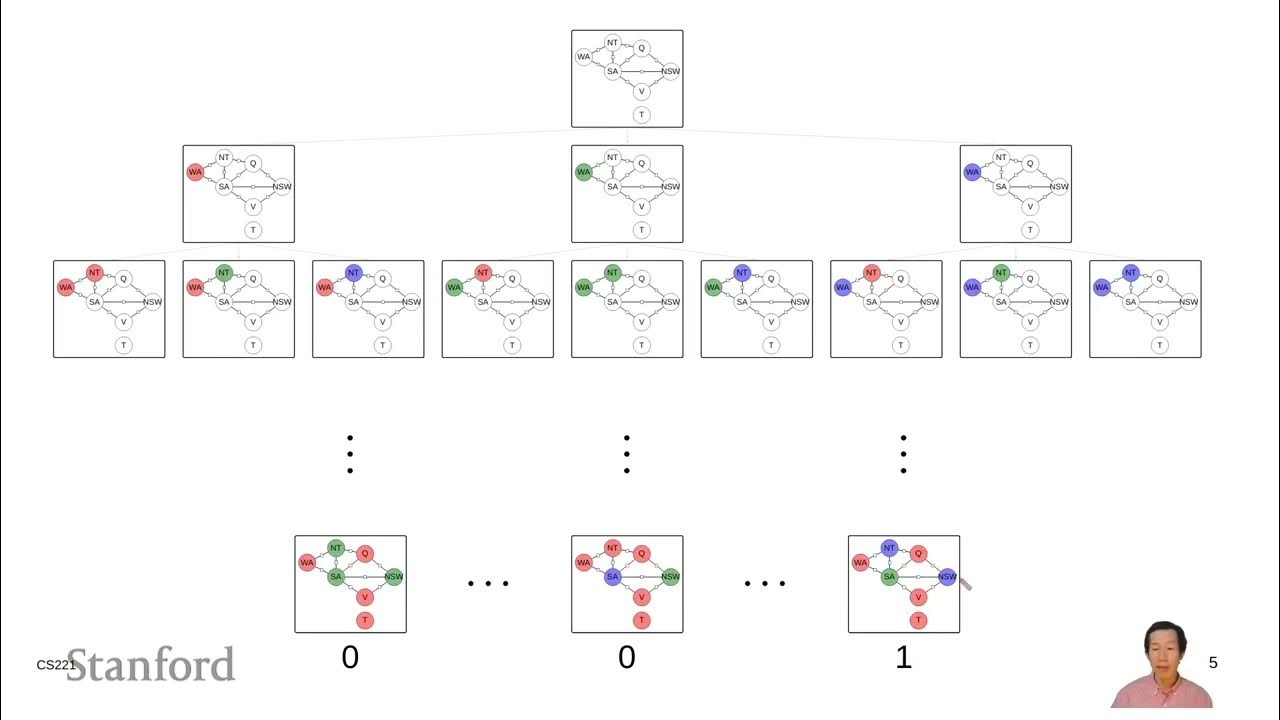CS3491 AIML – Constraint Satisfaction Problem (CSP) with Example in tamil
Summary
TLDRThis tutorial delves into Constraint Satisfaction Problems (CSP), with a focus on Cryptarithmetic problems. CSP involves finding solutions that satisfy a set of constraints, such as variables having unique values and satisfying arithmetic conditions. The video explains the key components of CSP, including variables, domains, and constraints, before diving into Cryptarithmetic puzzles where letters are replaced by digits to solve equations. The tutorial guides viewers through examples, clarifying the constraints, such as unique values and no leading zeros. It emphasizes the logical steps needed to find the correct solution to such problems.
Takeaways
- 😀 A Constraint Satisfaction Problem (CSP) involves finding solutions that satisfy a set of constraints or conditions.
- 😀 Variables in CSPs are assigned values from a defined domain, and the solution must satisfy specific constraints.
- 😀 In Cryptarithm problems, each letter represents a unique digit, and the goal is to solve the puzzle while respecting constraints.
- 😀 One key constraint in Cryptarithm problems is that each character must have a unique value assigned to it.
- 😀 Another constraint is that digits in a Cryptarithm puzzle must be between 0 and 9.
- 😀 Leading digits cannot be zero, meaning that the first character of a number cannot represent the digit 0.
- 😀 Cryptarithm problems also involve the concept of carrying in addition, where sums exceeding a single digit result in a carry to the next column.
- 😀 Solving a Cryptarithm puzzle involves assigning values to variables (letters) while ensuring all constraints are satisfied.
- 😀 The solution to a Cryptarithm puzzle should be the only valid solution that satisfies all the constraints, including the carry rule.
- 😀 Understanding how to handle carries in addition is crucial when solving Cryptarithm problems to maintain consistency in the equation.
Q & A
What is the main goal of a Constraint Satisfaction Problem (CSP)?
-The main goal of a CSP is to find a solution that satisfies a set of constraints imposed on the problem.
What are variables and their domains in the context of a CSP?
-In CSP, variables are represented as a set (e.g., x = x1, x2, ... xn), and each variable has a specific domain, which is the set of possible values that variable can take.
What are constraints in a CSP?
-Constraints in CSP are the rules or conditions that must be satisfied in order to find a valid solution.
What is a Cryptarithmetic problem?
-A Cryptarithmetic problem is a puzzle in which an easily readable message is encoded by replacing letters with numbers, making it more challenging to find the actual solution.
What are some key constraints in a Cryptarithmetic problem?
-Key constraints include that each character must have a unique value, digits should only be from 0 to 9, the starting character cannot be zero, and there should only be one solution when performing arithmetic operations.
Why can't the starting character in a Cryptarithmetic problem be zero?
-The starting character cannot be zero because it would lead to an invalid solution in terms of number representation, as leading zeros are not allowed in most number systems.
What happens when adding two numbers in a Cryptarithmetic problem?
-When adding two numbers, a carryover (or 'carry') may occur, which must be accounted for in the solution process to maintain the validity of the equation.
Can multiple values be assigned to the same variable in a Cryptarithmetic problem?
-No, each variable must have a unique value assigned to it in a Cryptarithmetic problem to ensure that the solution is correct and satisfies the constraints.
How is the Cryptarithmetic problem example in the video solved?
-In the example, variables are assigned specific digits, such as 'O' = 1 and 'T' = 2, and arithmetic is performed step-by-step, ensuring that the constraints are satisfied, leading to the final solution of 102.
What is the final solution to the Cryptarithmetic problem in the video?
-The final solution to the Cryptarithmetic problem in the video is 102.
Outlines

This section is available to paid users only. Please upgrade to access this part.
Upgrade NowMindmap

This section is available to paid users only. Please upgrade to access this part.
Upgrade NowKeywords

This section is available to paid users only. Please upgrade to access this part.
Upgrade NowHighlights

This section is available to paid users only. Please upgrade to access this part.
Upgrade NowTranscripts

This section is available to paid users only. Please upgrade to access this part.
Upgrade NowBrowse More Related Video

Introduction to Constraint Satisfaction Problems (CSP)

Constraint Satisfaction Problems (CSPs) 1 - Overview | Stanford CS221: AI (Autumn 2021)

An Introduction To Constraint Programming - Jacob Allen

Constraint Satisfaction Problems (CSPs) 2 - Definitions | Stanford CS221: AI (Autumn 2021)

Section 1 Worksheet Solutions: CSPs

AI - Ch03 - Uninformed search algorithms
5.0 / 5 (0 votes)